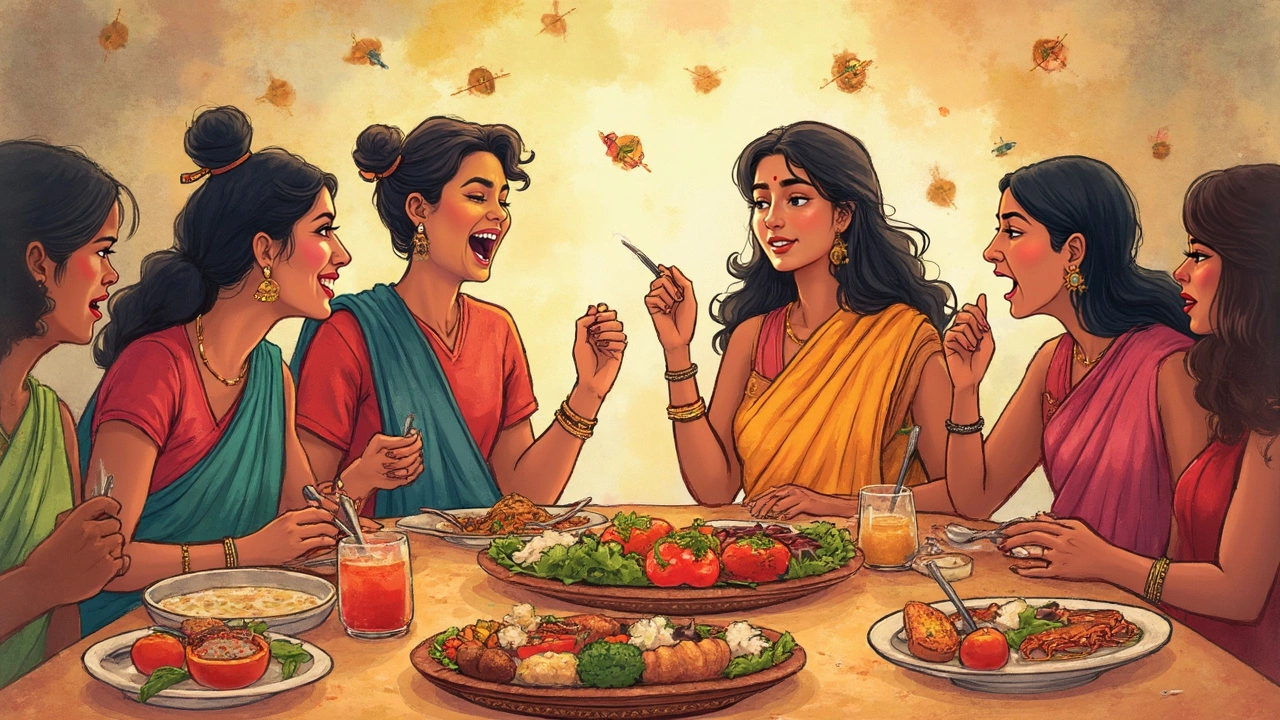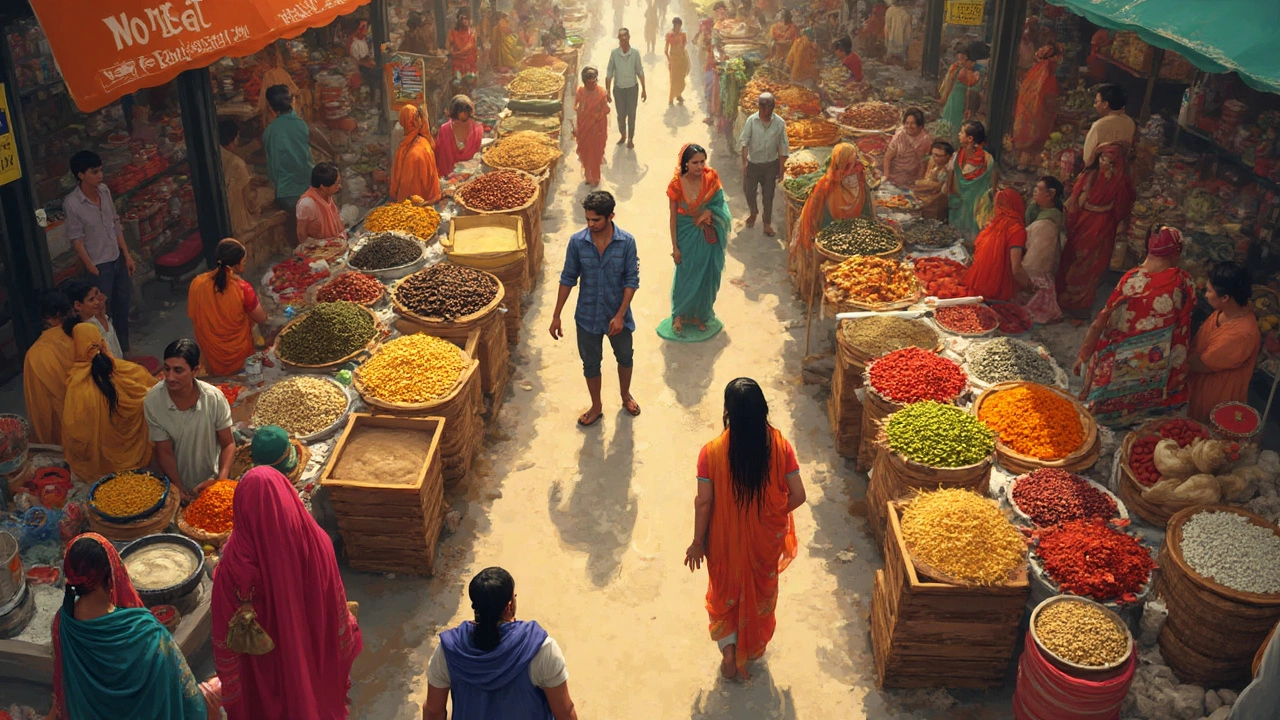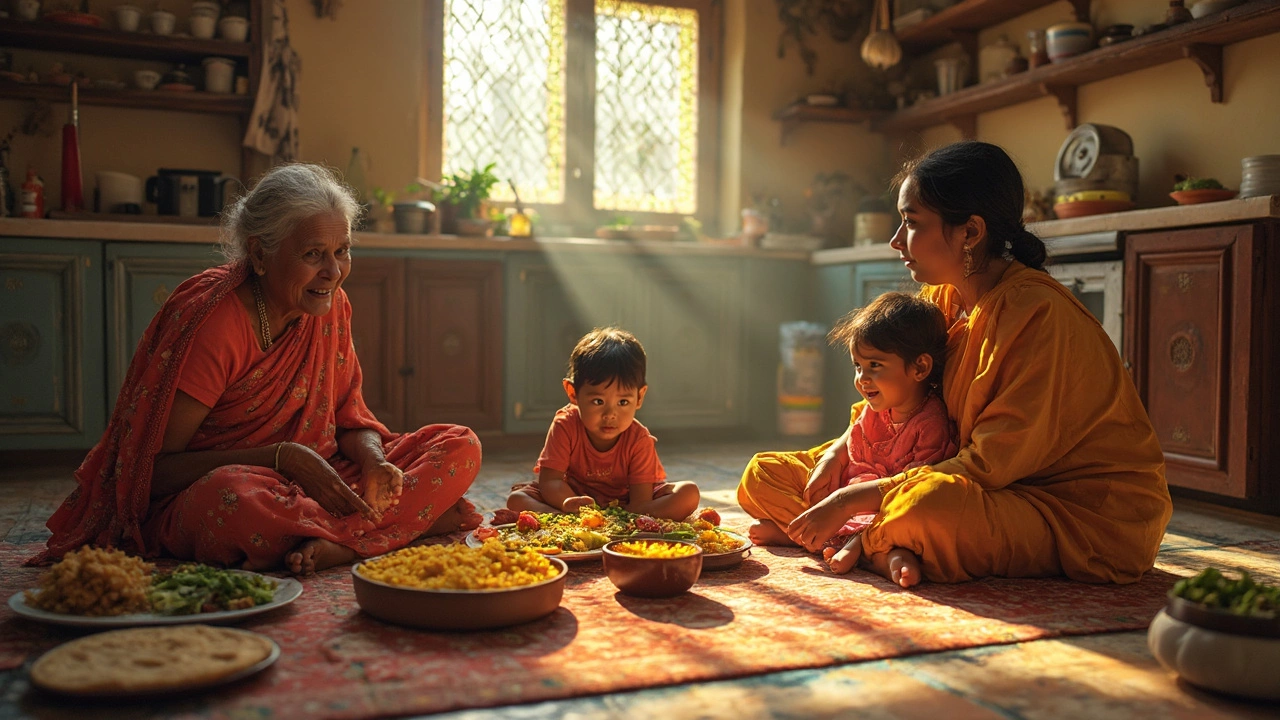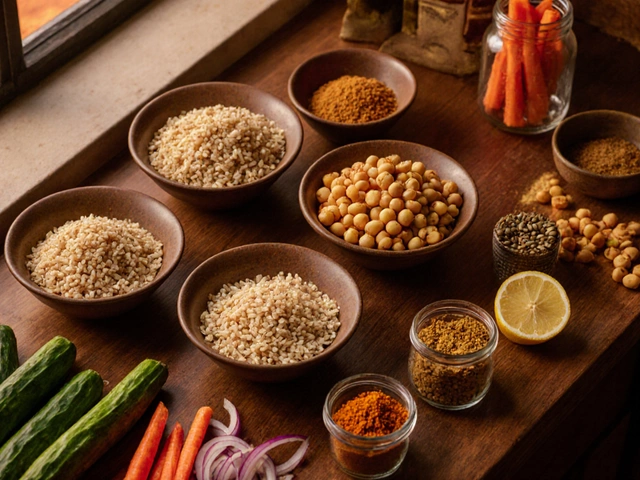Ever tried making an Indian recipe and gotten confused about what to leave out? You’re not alone. A huge part of Indian cooking is knowing what you shouldn’t use. That’s because people across India skip certain foods, sometimes without even thinking about it.
First thing you’ll notice in most Indian kitchens: beef is missing. It's almost never on the menu, thanks to deep religious roots. But it doesn’t stop there. You might be surprised to learn eggs, pork, seafood, and even onions and garlic get left out in many households as part of religious or family traditions. Certain foods are totally off-limits for some, while others just skip them on special days.
If you love cooking Indian food or want your meals to suit everyone at the table, knowing these common “no-go” items can really help. It saves side-eyes from guests and avoids awkward meal mishaps. Plus, there’s always a tasty plant-based workaround for almost everything you skip. That’s the best part—Indian cuisine is full of clever swaps, so you won’t even miss what’s not there.
- Religious Roots Behind Indian Food Choices
- Why Beef Is Mostly a No-Go
- Common Foods Skipped in Everyday Cooking
- Hidden Animal Products to Watch Out For
- Tips for Making Inclusive Indian Recipes
Religious Roots Behind Indian Food Choices
If you want to cook Indian meals that make everyone happy, you’ve got to understand why certain foods get skipped. The answer is simple: religion. But there’s a lot going on! Different communities have totally different do’s and don’ts when it comes to what ends up on their table.
Let’s start with Hindus, who make up about 80% of India’s population. For most Hindus, eating beef is off the table—literally—because the cow is considered sacred. That’s why you’ll rarely see beef burgers or steak on an Indian menu. Then there are Jains, a much smaller group but strict when it comes to food. Jains ditch not only meat and eggs but also root vegetables like onions, garlic, and even potatoes. Their focus is on non-violence, so they avoid anything that might harm even the tiniest form of life in the soil.
Muslims in India stay away from pork because of religious rules, but beef is allowed. Sikhs skip beef too (in honor of the Hindu tradition) but are fine with most other meats. Even Buddhists, depending on the region, tend toward vegetarian meals as a way to reduce harm. Here’s a quick cheat sheet so you’re not caught off-guard:
| Community | Commonly Avoided Foods |
|---|---|
| Hindus | Beef |
| Muslims | Pork, alcohol |
| Jains | Meat, eggs, onion, garlic, root veggies |
| Sikhs | Beef (sometimes eggs, depending on tradition) |
This isn’t just about following rules. Food is actually a huge part of family and social life in India. People plan menus for big events based on these beliefs, and festive recipes skip all the forbidden stuff automatically. If you’re serious about cooking Indian food restrictions the authentic way, it pays to ask your guests or friends up front what they don’t eat. Saves both time and stress. And honestly, it shows you care.
Why Beef Is Mostly a No-Go
Walk into most Indian homes, and you just won’t find beef in the fridge. This isn’t a trend or a diet fad—it's mostly about respect for religious beliefs. Nearly 80% of Indians identify as Hindu, and for them, the cow is seen as sacred. Eating beef isn’t just uncommon, it’s often considered disrespectful and, in many states, flat-out illegal.
Some states like Uttar Pradesh, Gujarat, and Rajasthan have outright bans on beef. Even bringing beef into these locations can cause legal trouble. Here's a quick look at the beef laws by region:
| State | Is Beef Legal? | Penalty |
|---|---|---|
| Gujarat | No | Up to 7 years in jail |
| Maharashtra | No | Up to 5 years in jail |
| Kerala | Yes | None |
| West Bengal | Yes | None |
| Uttar Pradesh | No | Up to 10 years in jail |
Even in places where it’s legal (like Kerala and West Bengal), most Hindus still avoid it, and beef dishes stay pretty rare outside of specific communities. The bigger cities might have international restaurants that serve beef, but most local eateries don't bother. In fact, sticking to a Indian diet means focusing on chicken, mutton (goat or lamb), and lots of plant-based stuff.
Why does this matter for home cooks? It means when you’re making Indian recipes, beef isn’t just unnecessary—it might be unwelcome if you’re feeding friends or neighbors with Indian roots. If a recipe calls for red meat, try switching it out for goat, lamb, or just double up on hearty veggies and paneer instead.

Common Foods Skipped in Everyday Cooking
When it comes to daily meals, most Indian homes draw clear lines about what stays out of the kitchen. It's not just about meat—lots of common foods don’t make the cut, and these choices go way beyond personal taste. Family traditions, religious rules, and even the region you live in, all affect what's on the plate.
Beef tops the list of things you almost never see in Indian home cooking, especially in Hindu and many Christian and Buddhist families. Next up is pork, which many Muslims and some Hindus avoid. Eggs and seafood don’t show up often either, especially among vegetarians, which make up nearly 40% of India's population according to a 2022 survey by Statista.
But it gets trickier. Some households—especially those following strict Jain, Vaishnav, or certain Buddhist practices—also avoid onion and garlic. These are known as "tamasic" or "rajasic" foods and are believed to affect mood and meditation. Even root vegetables like potatoes and carrots sometimes get skipped, mostly for religious reasons during festivals.
- Beef and pork are the most widely skipped meats in India.
- Eggs aren't as common as you might think, especially in vegetarian families.
- Seafood is mostly skipped in landlocked regions like Rajasthan, Punjab, and Haryana.
- Onion and garlic are a total no-go in many temple kitchens and during festivals like Navratri.
- Alcohol and certain spices (like hing/asafetida, since it can be animal-derived) are sometimes avoided in religious homes.
If you’re planning to cook for an Indian crowd, you’ll want to double check which of these ingredients people avoid. Nobody wants unexpected drama at dinner.
| Food Item | Typical Reason Skipped | Regions/Groups Affected |
|---|---|---|
| Beef | Religious | Hindus, Christians, Gujaratis, Rajasthanis |
| Pork | Religious/Cultural | Muslims, some Hindus |
| Eggs | Vegetarianism | States like Gujarat, parts of South India |
| Onion/Garlic | Religious/Fasting | Jains, Vaishnav Hindus, some Buddhists |
| Root Vegetables | Fasting/Religious | Jains, during certain festivals |
Sticking to dal, sabzi (vegetable dishes), rice, and roti with basic spices is usually a safe bet. And if you’re ever in doubt, just ask—most people are totally fine sharing what works for them.
Hidden Animal Products to Watch Out For
You’d be shocked how many sneaky animal products show up in store-bought ingredients. A lot of people in India avoid meat, but they also skip anything that might have hidden animal bits, even in things that sound totally vegetarian.
Let’s talk basics. Ghee and paneer are fine—they’re dairy, totally common in vegetarian Indian homes. But here’s where it gets tricky:
- Gelatin: Found in some Indian desserts, jellies, and even yogurt. Gelatin is made from animal bones. Always check the label—sometimes “jelly crystals” and gummy treats aren’t vegetarian at all.
- Anchiovies & Fish Sauce: Not common in classic Indian recipes, but sometimes show up in packaged sauces and snacks, especially those with a “masala” flavor.
- Eggs in Baked Goods: A lot of Indians avoid eggs, so biscuits and bread from local bakeries are often eggless. Imported cookies and cakes? Not always egg-free.
- Animal Rennet: Used to set cheese. Most Indian paneer is made with lemon juice or vinegar, but imported cheeses may use rennet, which is not vegetarian.
- Meat Stock Cubes: Some packaged curries, noodle packets, and snack mixes have meat-based flavor cubes. Look for "vegetarian" on the pack, but read the ingredients, too.
If you’re following Indian food restrictions or cooking for someone who does, labels are your best friend. Some popular packaged food brands in India started printing a green or red dot to show if something is vegetarian or not. This system isn’t perfect, so a quick label scan is still smart.
| Ingredient | Typical Use | Hidden Animal Product? |
|---|---|---|
| Gelatin | Desserts, yogurt, candies | Yes |
| Rennet | Cheese (especially imported) | Yes |
| Egg Powder | Cakes, biscuits, some snacks | Yes |
| Fish Sauce | Asian sauces, some snack mixes | Yes |
| Meat Stock | Packaged soups, ready-to-eat meals | Yes |
Mastering Indian home cooking means knowing where these animal products could be hiding. Want to keep your food truly vegetarian? Look out for the Indian food restrictions label details and try making as much from scratch as you can. You’ll dodge animal-based surprises and keep everyone happy at mealtime.

Tips for Making Inclusive Indian Recipes
Cooking for a crowd in India can feel like solving a food puzzle. Everyone has different food restrictions. But here’s the thing: you can whip up dishes that make everyone happy without making a dozen versions of the same meal.
First up, go with plant-based proteins like lentils, chickpeas, and tofu. These slip right into classics like dal, chana masala, and even kebabs, and they’re safe bets if you’re trying to please vegetarians and those who skip eggs and meat. India has more vegetarians than anywhere else—about 31% of Indians stick to a vegetarian diet, so it's a solid place to start.
Leave out beef, pork, and sometimes seafood unless you know your guests are cool with it. Lamb, chicken, or paneer work as “main” ingredients if you want some variety in your spread. Want to play it safe on the spice front? Skip onion and garlic for religious reasons by using asafoetida (hing) and ginger for flavor. Jain-friendly Indian food does just that.
Not sure what is safe? Just ask! Most people appreciate it and will even give you tips from their own homes. You’ll find dietary restrictions are usually tied to big religious or cultural events—festivals like Navratri or Paryushan, when people avoid certain foods altogether.
| Ingredient | Common Reason Skipped | Easy Substitute |
|---|---|---|
| Beef | Religious beliefs (Hinduism) | Lamb, paneer, soya chunks |
| Pork | Religious beliefs (Islam) | Chicken, jackfruit |
| Seafood | Regional or allergy concerns | Vegetables, tofu |
| Eggs | Vegetarian diets | Paneer, potatoes |
| Onion & Garlic | Jain and certain Hindu traditions | Asafoetida, ginger |
If you’re cutting out dairy for vegans, swap in coconut milk or cashew paste for cream. And don’t forget, the Indian food restrictions list gets even longer during fasting seasons, so double-check before you shop or cook.
- Read labels if you use packaged spices—sometimes they sneak in animal products.
- Make separate sections for condiments so people can pick and choose.
- Keep at least one fully vegan option at the table if possible.
If you put a little thought into these swaps and checks, you can pretty much guarantee your Indian recipes will be crowd-pleasers—even for the trickiest eaters.











